ikfoundation.org
The IK Foundation
Promoting Natural & Cultural History
Since 1988


VESTMENTS AND EMBROIDERIES
– Medieval Textiles
In this second historical essay of the Medieval textiles in St Petri, once part of the church’s liturgical traditions, some comparisons with other contemporary collections and a brief introduction to the practice and the use of silk, velvet and linen vestments will be looked at more closely. A selection of images depicting the preserved fragments with intricate silk and gold embroideries, together with a fully preserved cope from nearby Lund Cathedral and a 15th-century book illustration will aid this study. Characteristics of these beautiful embroideries were the complex laid work technique, including fine silk threads, often dyed in intense red, blue or green shades and a rich quantity of metallic gold or silver threads.
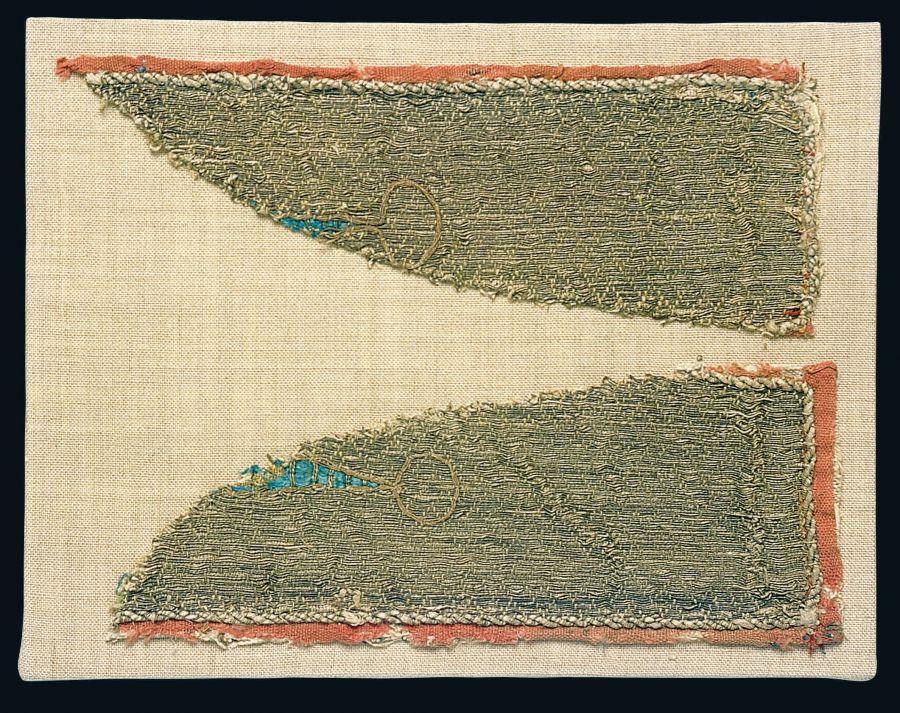 The two embroidered fragments were possibly part of the same dalmatic. This embroidery was stitched in a style of surface covering laid work, common in Medieval ecclesiastical embroideries. The small silk stitches were carefully repeated in the same design, while the metallic gold thread today has darkened in colour. Furthermore it is visible that the laid work was originally stitched on plain woven red linen, small areas of the original figures in blue silk is still visible. Both fragments have an approximate size of; width 23 cm and height 8,5 cm. Photo: The IK Foundation, London.
The two embroidered fragments were possibly part of the same dalmatic. This embroidery was stitched in a style of surface covering laid work, common in Medieval ecclesiastical embroideries. The small silk stitches were carefully repeated in the same design, while the metallic gold thread today has darkened in colour. Furthermore it is visible that the laid work was originally stitched on plain woven red linen, small areas of the original figures in blue silk is still visible. Both fragments have an approximate size of; width 23 cm and height 8,5 cm. Photo: The IK Foundation, London.Even if the Medieval textiles of St Petri church, to a great extent, include fragmented pieces – of nine chasubles, three copes, one respective of dalmatic, altar cloth and profane coat – the original uses are well documented by the Swedish National Heritage Board. The more questionable fragments are believed to have been from an unspecified garment, a linen shirt, two fringes once part of altar cloths and embroideries, which were possibly decorations on chasubles. It can also be concluded that 50-60% of the preserved pieces were part of chasubles; a similar result can be traced to other church collections. A circumstance researched by the late textile historian Agnes Geijer, who, for example, mentioned that an inventory dated 1552 from St Mary’s church in Danzig [Gdańsk] registered 342 textiles, whereof 229 or 67% were chasubles. Emphasising that the chasuble was a more commonly used garment than copes or dalmatics during the late Medieval period and Reformation.
-664x863.jpg) This 15th century book depiction illustrating a Mass, gives examples of the cut and use of vestments as well as the design of an altar cloth in a Catholic church. (Courtesy of Wikimedia Commons: Pontifical Mass, from a Missal of the 15th century. British Museum, 19897).
This 15th century book depiction illustrating a Mass, gives examples of the cut and use of vestments as well as the design of an altar cloth in a Catholic church. (Courtesy of Wikimedia Commons: Pontifical Mass, from a Missal of the 15th century. British Museum, 19897).The dalmatic was in contrast to the sleeveless chasuble, a vestment with a short sleeve, primarily used by the deacon when assisting the priest. During the late Medieval period, the cope was in use by priests as well as bishops, a mantel-like garment open at the front with a hood. Other clothing used in connection with the Mass was, first and foremost, linen. In the St Petri collection, a linen fragment is the only proof of this important material for shirts etc. However, it is usual that all sorts of linen garments were worn out due to washing, smoothening with stones, and finally often recycled as rags and are therefore rare. One exception of few is a fully preserved Mass shirt in a standard Medieval floor-length model with long sleeves narrowing towards the wrist, kept in the Cathedral Museum in nearby Lund.
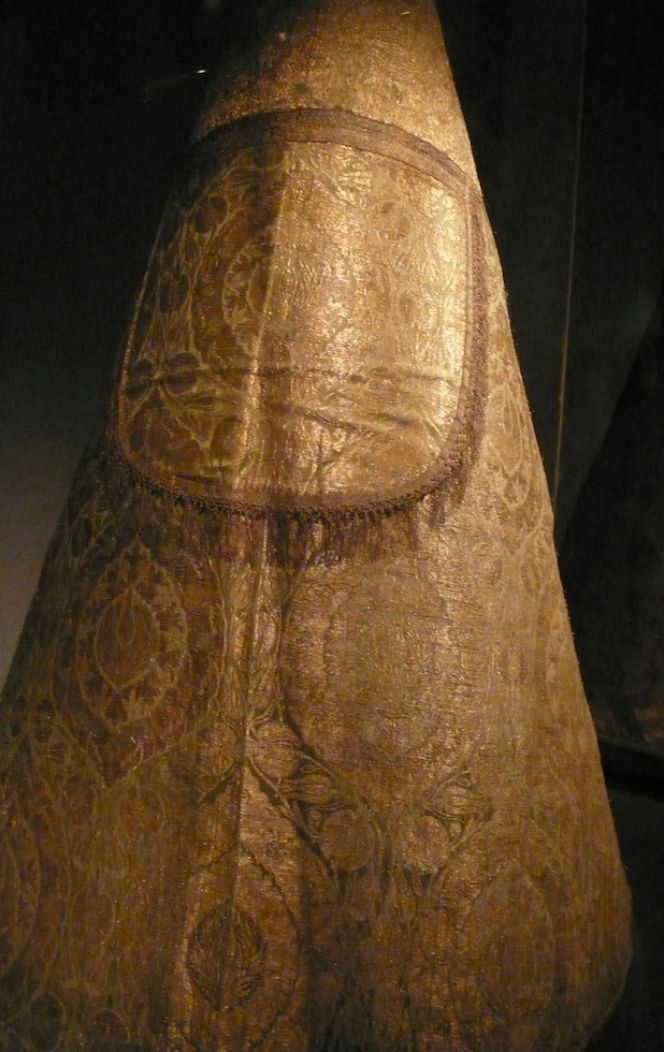 Fully preserved vestments once used in Lund Cathedral can be used as a comparable source to the fragments of St Petri church, these church textiles displayed in the Cathedral Museum dates from the 13th century and onwards. This cope of velvet brocade could be a representative garment demonstrating the luxury materials often preferred in Cathedrals and larger Medieval churches. The complex fabric of Italian import was woven from 1475 to 1525 in a technique of cut and uncut red velvet on a gold/metallic ground. The cope is further decorated with a silk fringe. (Photo: Viveka Hansen, exhibition at Cathedral Museum, Lund University Historical Museum).
Fully preserved vestments once used in Lund Cathedral can be used as a comparable source to the fragments of St Petri church, these church textiles displayed in the Cathedral Museum dates from the 13th century and onwards. This cope of velvet brocade could be a representative garment demonstrating the luxury materials often preferred in Cathedrals and larger Medieval churches. The complex fabric of Italian import was woven from 1475 to 1525 in a technique of cut and uncut red velvet on a gold/metallic ground. The cope is further decorated with a silk fringe. (Photo: Viveka Hansen, exhibition at Cathedral Museum, Lund University Historical Museum).The altar was originally without decorations, but gradually, various traditions developed, including ornamental textiles like altar cloths, antependiums and altar cushions or borders. In the St Petri collection, one velvet border with embroidery once used for the altar is the only preserved item. Additionally, the earlier mentioned fringes may have been part of the decorative textiles intended for this church altar during the Medieval period.
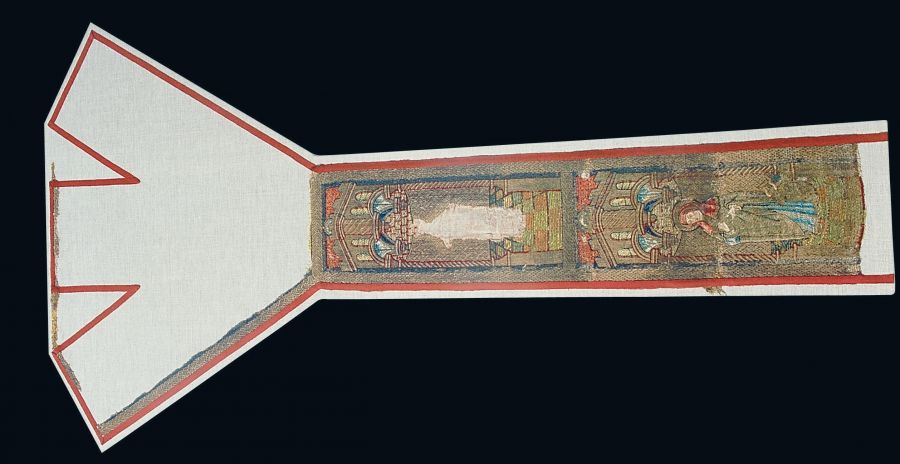 This fragmented cross from a chasuble was made around the year 1500 of the most exquisite silk and gold figure embroidery. It was probably embroidered in Flanders – an area known for its extremely delicate and beautiful work. Its shape is reconstructed; the figures depict John the Baptist and Brigit of Kildare (c.451-525) a patron saint of Ireland. Largest height 126 cm and largest width 69 cm. Photo: The IK Foundation, London.
This fragmented cross from a chasuble was made around the year 1500 of the most exquisite silk and gold figure embroidery. It was probably embroidered in Flanders – an area known for its extremely delicate and beautiful work. Its shape is reconstructed; the figures depict John the Baptist and Brigit of Kildare (c.451-525) a patron saint of Ireland. Largest height 126 cm and largest width 69 cm. Photo: The IK Foundation, London.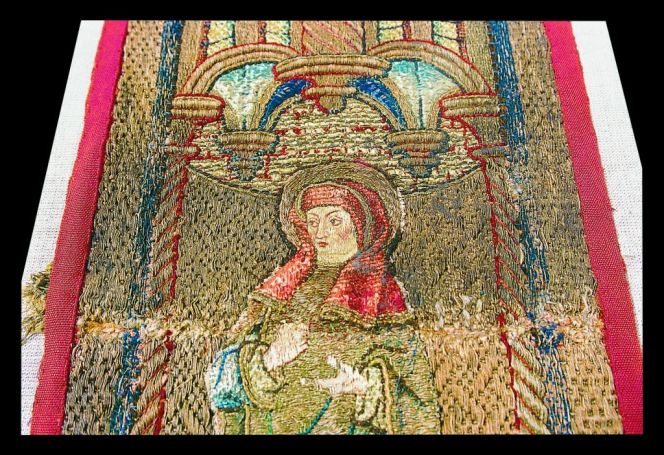 A close-up detail of the patron saint Brigit of Kildare of Ireland, demonstrates the amount of gold metallic thread used in this laid work, while various shades of fine silk gives life to faces, clothing, architectural details as well as fastening the gold embroidery with fine stitching. Photo: The IK Foundation, London.
A close-up detail of the patron saint Brigit of Kildare of Ireland, demonstrates the amount of gold metallic thread used in this laid work, while various shades of fine silk gives life to faces, clothing, architectural details as well as fastening the gold embroidery with fine stitching. Photo: The IK Foundation, London. Judging by preserved vestments in the Nordic area, so also in St Petri, it was foremost during the later part of the Medieval era (1470-1525) that the churches invested in substantial amounts of exclusive textiles. The imported fabrics came into the Nordic area either via the church’s representatives themselves or from the town merchants through a complex trading network connected to Italy, Spain etc – areas where silk brocades and other desired qualities were woven. These types of expensive fabrics were used for liturgical purposes as well as for the wealthy citizens' clothing and textile interiors. Goods like these usually get their final “religious stamp” after reaching the Nordic market. Tailors and probably seamstresses also sewed the chasubles and other vestments of the imported silk, velvet or linen qualities. They added embroideries professionally made on the Continent or more close to home.
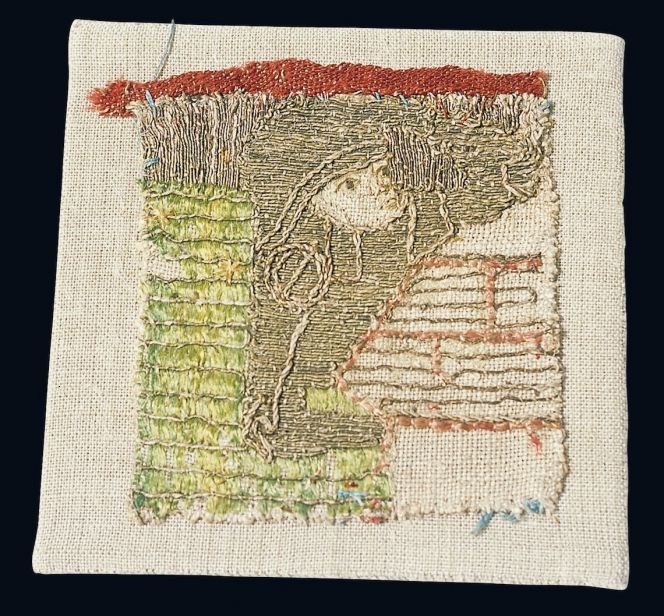 This laid work of gold and silk is simpler in style than many other studied examples and may depicts a 15th century knight in silver armour. But this fragmented piece can also be more than a century older – c. 1275-1360 – while research gives some indication for that this piece of embroidery belongs to the early Danish/Swedish heraldry tradition. The fragment is stitched on to a modern linen; height 9,2 cm and width 8,9 cm. Photo: The IK Foundation, London.
This laid work of gold and silk is simpler in style than many other studied examples and may depicts a 15th century knight in silver armour. But this fragmented piece can also be more than a century older – c. 1275-1360 – while research gives some indication for that this piece of embroidery belongs to the early Danish/Swedish heraldry tradition. The fragment is stitched on to a modern linen; height 9,2 cm and width 8,9 cm. Photo: The IK Foundation, London. Fragmented piece of a cope dating from the early 16th century – including a Continental figure embroidery in silk, metallic threads and a silk fringe. Photo: The IK Foundation, London.
Fragmented piece of a cope dating from the early 16th century – including a Continental figure embroidery in silk, metallic threads and a silk fringe. Photo: The IK Foundation, London.As the images in this essay clearly illustrate, the most common type of embroidery was a fully-covering figure style inlaid work of silk and metallic gold or silver threads stitched on fine linen. The most commonly depicted in fine stitching are Mary, either with her child Jesus or alone and the twelve Apostles or saints. Many of these fragmented figure embroideries were originally part of the cross on a chasuble, so while the vestment in itself became worn out, the delicate embroideries were often kept or re-used.
Notice: A large number of primary and secondary sources were used for this essay. For a full Bibliography and a complete list of St Petri church textiles, see the Swedish article by Viveka Hansen.
Sources:
- Hansen, Viveka, ‘Kyrkliga textilier i Malmö – från medeltid till barock’, Elbogen pp. 61-135. 2000.
- Lund University Historical Museum, The Cathedral Museum (studies/comparisons of ecclesiastical Medieval textiles in exhibition 2015, originally in use at Lund Cathedral).
- St Petri Church, Medieval Church Collection, Malmö, Sweden (researched in 1999 & 2000. If not otherwise stated, all textile fragments are part of the St Petri collection).
Essays
The iTEXTILIS is a division of The IK Workshop Society – a global and unique forum for all those interested in Natural & Cultural History from a textile Perspective.
Open Access essays, licensed under Creative Commons and freely accessible, by Textile historian Viveka Hansen, aim to integrate her current research, printed monographs, and earlier projects dating back to the late 1980s. Some essays feature rare archive material originally published in other languages, now available in English for the first time, revealing aspects of history that were previously little known outside northern European countries. Her work also explores various topics, including the textile trade, material culture, cloth manufacturing, fashion, natural dyeing, and the intriguing world of early travelling naturalists – such as the "Linnaean network" – viewed through a global historical lens.
For regular updates and to fully utilise iTEXTILIS' features, we recommend subscribing to our newsletter, iMESSENGER.
been copied to your clipboard




– a truly European organisation since 1988
Legal issues | Forget me | and much more...
You are welcome to use the information and knowledge from
The IK Workshop Society, as long as you follow a few simple rules.
LEARN MORE & I AGREE







